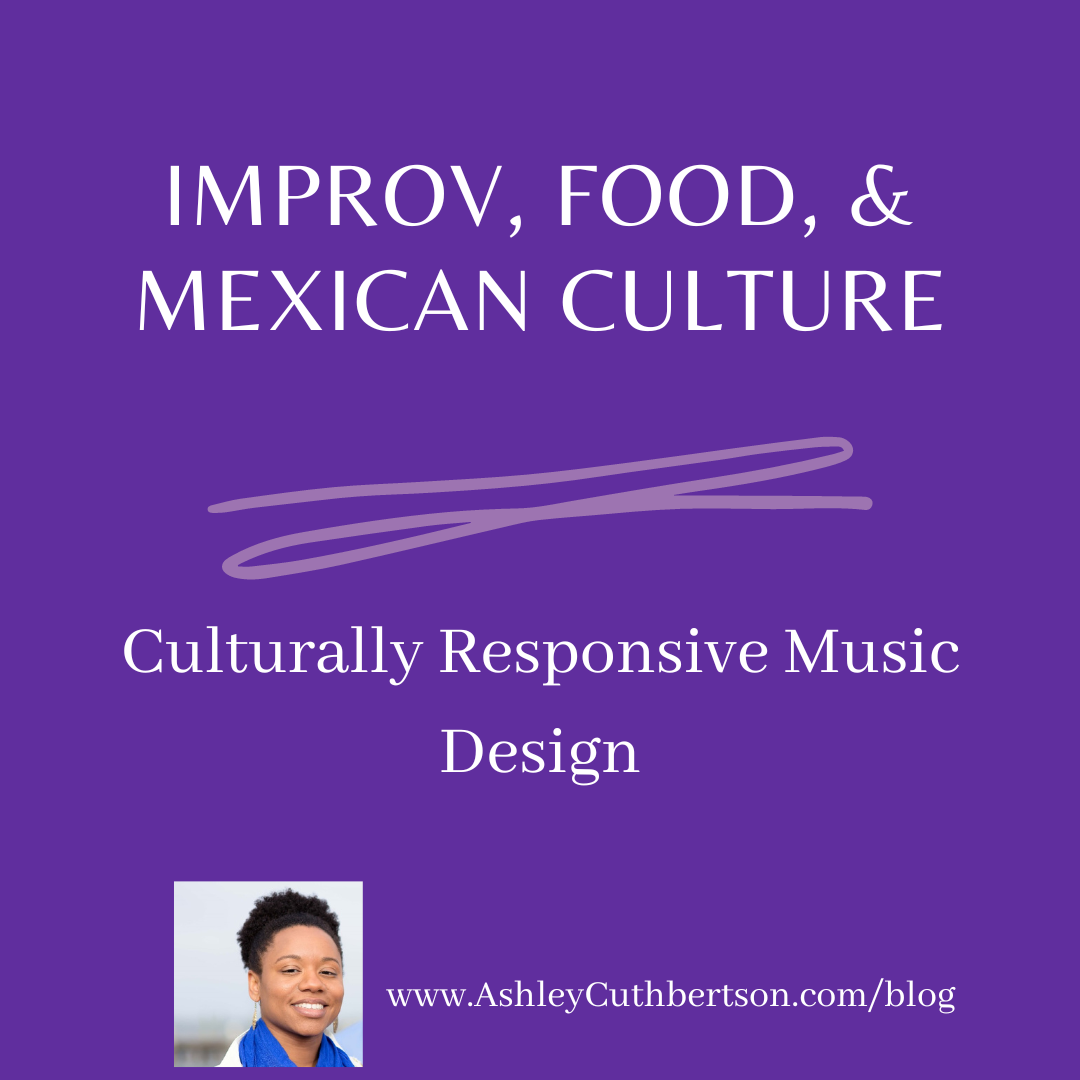Listen to this blog post by clicking the player below!
A common misconception about Culturally Responsive Music Education is that it’s just about utilizing diverse repertoire. And while this isn’t incorrect, it isn’t the full scope of what Culturally Responsive Music Education is.
Culturally Responsive Music Education is a robust approach to teaching music that utilizes students’ cultural frames of reference as assets in order to make music learning more relevant to them, while employing music as a vehicle for students to advance their understandings of self, others, and the world as they develop independent musicianship.
This means that we must intentionally seek to:
- Learn about and connect with our students so that we can better be responsive to their unique gifts and needs as we design our learning environment and lessons.
- Craft lessons that make relevant, real-world connections to music
- Craft lessons that further students’ musicianship skills
- Connect music learning to our students’ varied identities, and help them learn about and make connections to the identities of others different from them
- Connect music learning to understandings about the world around us
Ultimately, Culturally Responsive Music Education seeks to utilize music as the vehicle in which students gain understandings that will serve their lives. Of course we teach music concepts and skills, but it’s important to remember that music isn’t just notes on a page. We can’t stop at just teaching them how to read rhythms and sing, we must connect the learning to their world.
Designing Culturally Responsive Music Lessons
So how do we go about designing instruction that is culturally responsive in the music room?
Well, we need to make sure that we are utilizing the standards, using what we know about our students to make relevant real-world connections, selecting diverse and engaging musical materials, intentionally embedding learning about identity (both self and others), as well as related socio-political connections.
Here’s an example from a unit I’ve designed:
Unit: How do musicians create?
Exploring improvisation and food choices through Mexican culture
In this unit, the big connection I wanted students to make was to food choices and nutrition.
As I gathered repertoire that could help the students to make those connections, I came across a favorite resource of mine by Jose-Luis Orozco “De Colores: And other Latin American Folk Songs for Children.”

This resource is both a print book, and a recording! I love resources that include recordings because music is aural! We can’t really know how the music is to be performed until we hear it.
One of the primary pieces of repertoire I wanted to use in the unit was the song “El Chocolate.”
Here is Jose-Luis Orozco performing it with kids!
I gathered additional pieces of repertoire from Mexico, as well as spent some time learning more about Mexican culture, learning about the cacao bean (the subject of “El Chocolate”), as well as nutrition and food justice.
Once I had the background knowledge, I was then ready to select the standards, objectives, and summative assessment for the unit.
I listed the unit overview below and I also put together the unit overview and the first lesson from this lesson as a free resource for you! Click here to download it for free!
Exploring Improvisation & Food Choices Through Mexican Culture – Unit Objectives:
Perform: Students will..
- Sing music with others in unison
- Sing an echo
- Use movement to demonstrate rhythmic patterns
- Perform rhythmic patterns with quarter notes and paired eighth notes.
- Perform music with changes in tempo
Create: Students will…
- Create body percussion patterns utilizing two levels to match rhythms
- Create rhythmic phrases using text and movement
Respond: Students will…
- Demonstrate rhythms using body percussion
- Describe vocal timbres (adult, child)
Connect: Students will…
- Consider what foods they like to eat (self)
- Learn about the history of the cocoa bean, and various ways it is used in food (others)
- Learn about Mexican culture (others)
- Explore the importance of good nutrition, and why it is more difficult in some areas to obtain fresh food to support good nutrition (food justice) (world)
Music concepts:
- Rhythm: quarter note & paired eighth notes
- Part work: echo
- Expression: fast/slow, tempo, accelerando
Unit Summative Assessment Task: Students will create and perform a 4-beat rhythmic phrase utilizing text and simple rhythms (quarter & paired eighth notes).
The primary musical learning in the unit is quarter and paired eighth notes as well as improvisation. As we work to further those musicianship skills, we continuously connect back to a real-world connection: food! We explore the foods we like, the foods others like, common foods in Mexico, we use the text to create rhythmic patterns to share about food, and we also learn about why good nutrition is important and why it’s more difficult in some areas to obtain fresh food than others (food justice).
Here’s the link to a free download of the unit overview and the first lesson! In the first lesson you’ll see more specifically how I incorporated both the musical learning along with connecting to the real world connection as well as to Mexican culture.
Moving Beyond Facts & Skills Only Instruction
The ultimate goal of all instruction is to advance our students’ understandings of themselves and the world.
In our music rooms, we do this through the development of music concepts and skills, always with the understanding that we teach kids through the medium of music. The music is the vehicle for learning, it’s not the destination.
I encourage you to consider one small shift you could make in your next lesson plan as you move towards culturally responsive music design. Perhaps you take some time to really learn more about the culture of the song you are going to teach, or you begin your lesson writing process by first thinking about the real-world connection you could make.
How do you incorporate culturally responsive design in your music lessons?
I would love to hear how you’re incorporating culturally responsive design in your music lessons!
Share below or share on social media and tag me: I’m @ACuthbertson10 on Twitter & Instagram, and @ACuthbertsonConsulting on Facebook.
Also, let me know what you think of this post! If you haven’t already, be sure to sign up for my email newsletter where I send blog posts and other music ed resources and tips each week to help support you ensure all of your young musicians thrive.
Until next time,
Ashley
Don’t forget to share this blog post with a music teacher friend! Use the buttons below.
